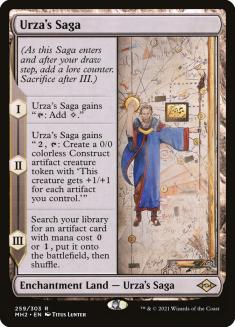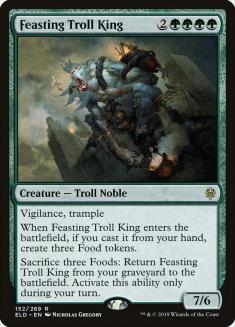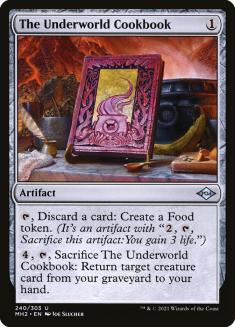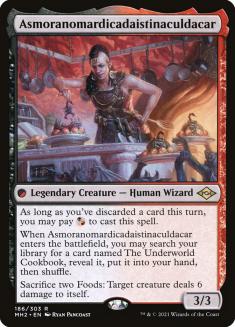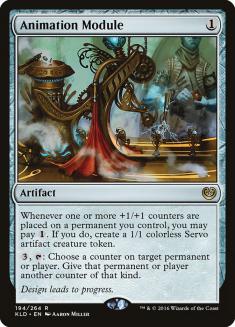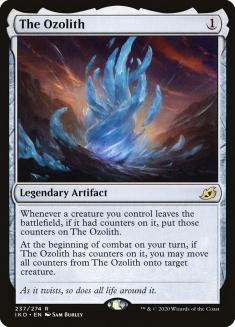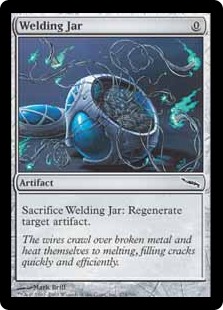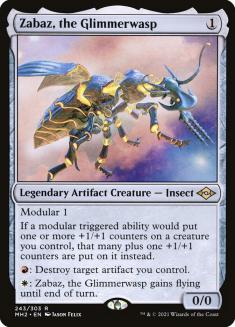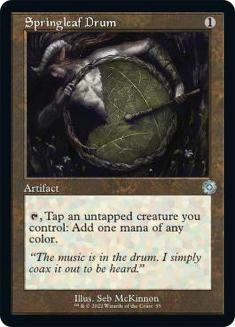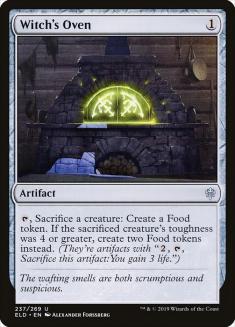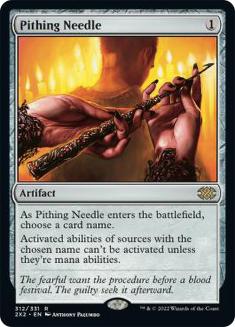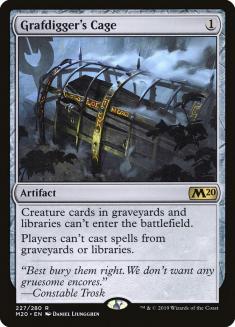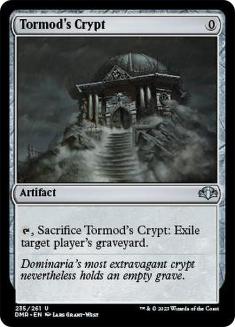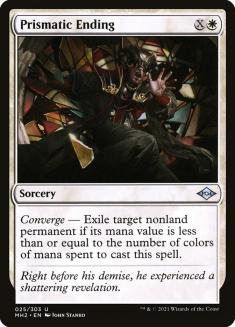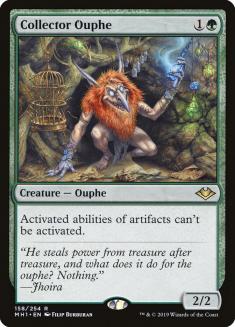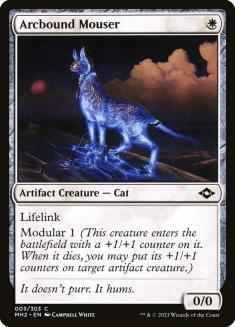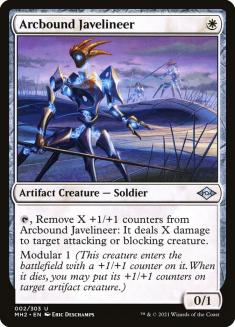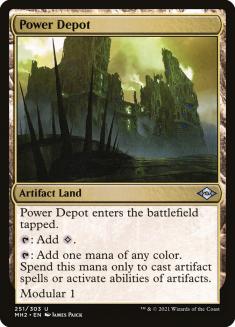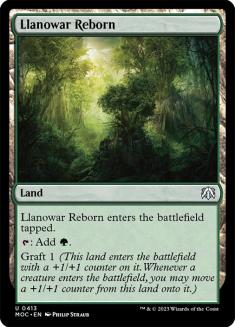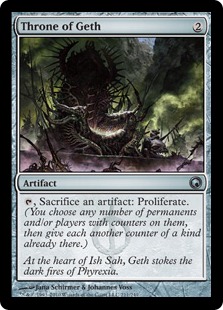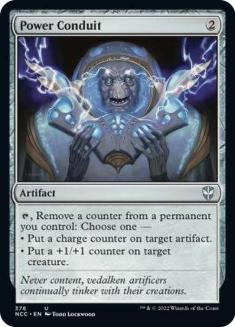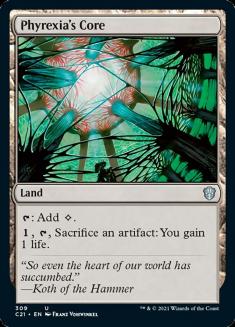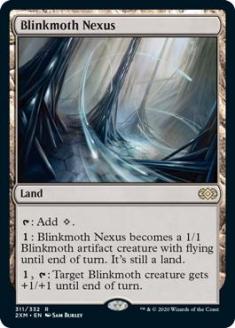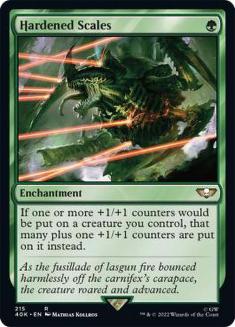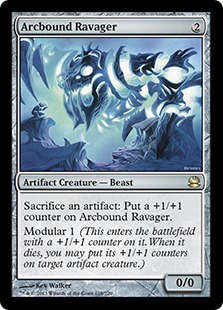I wanted to write about Hardened Scales as soon as possible with the release of Modern Horizons 2. It’s a personal favourite and fan favourite that was explicitly pushed in this set and seemed ready to make its return. For Week 1 at least it seemed more responsible to look at the results from the weekend instead and use them to form some first impressions of this new Modern.
Luckily, I get to do both!
Creatures (20)
Lands (24)
Spells (16)
- 1 Power Conduit
- 1 Welding Jar
- 4 Ancient Stirrings
- 2 Throne of Geth
- 4 Hardened Scales
- 1 Animation Module
- 3 The Ozolith
Sideboard

I won the Modern Challenge on Magic Online this past Sunday with a rough list of Hardened Scales trying as many of the new cards as possible. After this initial success, I’m confident that a more refined build can be a real player in Modern and have a better idea of what that looks like.
Let’s start with the elephant in the room:
I listed Urza’s Saga as my favourite card in the set and the one most likely to be banned and I think I was still underrating it. In just this first batch of results it can be found reviving artifact-centric decks like Lantern Control, bringing a scary speed and consistency to Amulet Titan, and even inspiring a new take on Azorius Control where the card is a flexible finisher and toolbox that can be woven into the manabase.
Urza’s Saga is also threatening to turn a cute gimmick that gets Twitter excited for a few hours into the second coming of Hogaak, Arisen Necropolis (from Throne of Eldraine, of course).
The card can show up in these unexpected places because very little work is required to make it good. Hardened Scales gets to make it great without even trying but this goes beyond the obvious truth that Constructs are better when you have artifacts lying around:
Previous Hardened Scales builds leaned on a web of engine pieces that each placed different demands on you. The Ozolith turbo-charges your best draws but requires a steady stream of creatures and is useless in multiples. Animation Module can out-grind anyone with the right tools but you can’t run too many copies when you can’t guarantee this is what the games will be about. Welding Jar is the best Spellskite you could hope for or a dead card whose greatest ambition is being sacrificed to Arcbound Ravager.
Draws with several of these conditional cards were more susceptible to interaction of any kind but there weren’t alternatives that were strong across the board so some mix of them was necessary. The rest of Modern Horizons 2 fills in those gaps and Urza’s Saga lets you enjoy consistent access to these effects with minimal risk of flooding on them.
After making two threats with Urza’s Saga, sometimes you just want a third. Zabaz, the Glimmerwasp is the best one given the constraints of the deck and is a searchable Hardened Scales imitation for Arcbound Ravager or the other, more dopey modular creatures. As I’ll cover in Zabaz’s own section, sometimes the best reason to find Zabaz is that you already have one.
The list I used as a starting point came from Scales expert Joan Carrasco (@MrSeriMTG) who was trying a wide array of Urza’s Saga targets. Witch’s Oven is likely too narrow (especially with Zabaz moonlighting as a fetchable sacrifice outlet sometimes) but their inclusion of Springleaf Drum was smart and I regretted cutting it. Hardened Scales is an incredibly mana-hungry deck and you’re often exactly one mana short of finding a lethal line or accomplishing some short-term goal. Drum offering a form of mana fixing (letting you keep hands with all colourless lands and still cast Stirrings or Scales) and unlocking both abilities on Zabaz is useful too.
A fundamental weakness of Hardened Scales is that it lacks the raw speed to compensate for a lack of interaction — linear decks that don’t have to win in combat are tough matchups (though Walking Ballista dominates the game against creature decks often enough that you claw back some equity there). Hate in the form of cheap artifacts is the best way to repair those matchups and Urza’s Saga lets you hedge against all of them and avoid the classic Modern dilemma of picking which combo decks you don’t want to lose to this week. If a clear target does emerge, several copies of Pithing Needle or some equivalent alongside Urza’s Saga and Ancient Stirrings will make Needle or its equivalent a reliable feature of sideboard games.
The full range of interaction from discard and counters to removal all received a substantial boost is Modern Horizons 2 and each of these can be problematic for Hardened Scales. Urza’s Saga bypasses or grinds through all of these and boasts card types that are hard to interact with profitably. Urza’s Saga may be the single biggest issue for Counterspell in Modern right now — it’s so strong against reactive strategies that control decks that play Saga themselves are likely to be heavily favoured in mirrors.
Nobody is prepared for Hardened Scales specifically (at least they weren’t on Sunday) but it suffers splash damage from the go-to hate for artifact and graveyard decks. Large Constructs are the easiest way to power through this.
Hardened Scales gets the other additions from Modern Horizons 2 all to itself:
As a Hardened Scales enthusiast, I expected to be an ardent member of the Zabaz hive but I’m more confused than excited. Urza’s Saga is a deeply strange card but leans into that and there’s a lot of value in pushing the envelope with designs like that; Zabaz is needlessly complicated and hard to parse without any real reward. I expect a lot of judge calls (or pregnant pauses on Magic Online for now) as players understandably but incorrectly assume that ‘Modular N’ is itself a ‘modular triggered ability’ or that Zabaz’ replacement ability boosts its own Modular trigger when it dies.
Its activated abilities are seemingly random (why does a wasp not have flying as a default?) without the context of needing to fix its colour identity for Commander. At this point, with Commander the most popular format and a focus of every new set, these questions should be dealt with in-house and with a clear design philosophy rather than forcing designers to jump through these hoops just so that a card can meet arbitrary, outdated criteria for colour identity.
Look, Zabaz and I got off to a bad start. I meant what I said and I still find Zabaz needlessly confusing but you can’t hope to change others. I have to accept it for who it is, remember that it doesn’t have flying before I send it to its death in combat again, and find a way to explain what a ‘modular triggered ability’ is that doesn’t sound like I’m trying to swindle my opponent.
Zabaz is good because Arcbound Worker is good; cheap modular creatures enable the low-friction resource conversion that sets up sudden kills and makes the deck tricky to play against. A draw with several Arcbound Workers and no sacrifice outlet doesn’t do anything but extra copies of Zabaz play off each other to stack up counters. If you have a pair of Zabaz by themselves, the second dies to the legend rule and makes the first a 3/3. Hardened Scales, as always, makes this more impressive:
- Turn 1: Cast Zabaz.
- Turn 2: Cast Hardened Scales, then a second Zabaz. This Zabaz enters the battlefield with two +1/+1 counters and dies to the legend rule. Those counters are transferred by Modular and boosted by both Scales and the original Zabaz, making it a 5/5.
Or work The Ozolith into this sequence too:
- Turn 1: Cast Hardened Scales.
- Turn 2: Cast a 2/2 Zabaz and The Ozolith.
- Turn 3: Cast a second Zabaz. This puts four counters on Zabaz as before, but The Ozolith also gains two counters and can give three to Zabaz thanks to Scales, leaving a 9/9 Zabaz. If it dies, its counters go back on The Ozolith ready to load up something else.
Without a sacrifice outlet — often a limiting factor here in previous versions — we have assembled a large creature that’s easily replaced while Arcbound Worker would just take up space. Note that Urza’s Saga can substitute for Zabaz or The Ozolith here.
A heavier focus on white opens up even more modular creatures but these are hard to cast in a deck with a lot of green or colourless lands and having to wait to cast them negates the main advantage of having a high density of one-drops.
These mana concerns are one reason why Lurrus of the Dream-Den isn’t automatic but the deck’s play patterns are also less conducive to it than you might think. It’s not just that Hardened Scales is full of mana sinks (decreasing the marginal utility of another one), it’s that many of these are tied up in its lands and this flood insurance is one of the deck’s major selling points.
If you aren’t animating Inkmoth or Blinkmoth Nexus, you’re making a Construct with Urza’s Saga or threatening a Pendelhaven or Phyrexia’s Core activation. Other mana sources are likely to disappear — Power Depot is Arcbound Ravager food and the Horizon Canopy you want in Selesnya won’t help you pick up or cast Lurrus if it’s being cashed in for a new card. Three mana on both ends to deploy Lurrus is an even steeper cost here than in most decks. It doesn’t help that the “free” Selesnya land is Branchloft Pathway, which often has to be played as a green source to cast Hardened Scales or Ancient Stirrings.
Llanowar Reborn snuck into Hardened Scales once the loss of Mox Opal forced you to play more lands and it now faces stiff competition from Power Depot. Llanowar Reborn still makes a strong case as a green source that’s more likely to have an immediate impact on the game — Turn 1 Llanowar Reborn grafting onto a Turn 2 Walking Ballista to trade with Stoneforge Mystic / Dauthi Voidwalker or shoot a Noble Hierarch while keeping Ballista around is a common and important line — but Power Depot has a higher ceiling as an artifact land with modular that makes Arcbound Ravager even better.
Depot makes it much easier to expose an early Ravager to Lightning Bolt (as Depot can put two counters on Ravager, only requiring one more artifact to let it survive) and Ravager in turn makes every other creature both safer and stronger. Once your battlefield is more developed, Power Depot and Zabaz make the Ravager lethal math much easier.
Power Depot and Urza’s Saga both being vulnerable to Disenchants is another reason to play more lands and something to keep in mind when planning your sequencing.
Throne of Geth went from an unreliable card that made up the numbers to one of your big hits thanks to The Ozolith and its stock rises even higher with the bigger modular package. Power Depot, in particular, allows Throne to distribute and stack up counters at will without losing Throne itself or an artifact creature it wanted to boost. It’s also easier to accommodate yet another two-drop as these new additions mean you don’t have to bother with Steel Overseer / Metallic Mimic / Scrapyard Recombiner.
With this in mind, Power Conduit earned an audition. It always had some utility in the shell, shuffling around counters for free (with Scales enhancing these and letting Conduit add a counter to a creature by removing and retargeting it) but this wasn’t enough. Its new trick is pairing with Urza’s Saga to let you find an artifact every turn (by removing the counter while the final chapter is on the stack to keep Saga at two counters in perpetuity) while putting a free counter elsewhere and churning out a Construct. That interaction is incredibly powerful (and worth exploring in some other shell, perhaps with The Antiquities War to find and combo with Conduit) but unfortunately not worth keeping here; the games where you have an uncontested Urza’s Saga mostly win themselves.
The tertiary colourless lands are being edged out by these new printings but you can still support them in small numbers. Additional sacrifice outlets (and decreased reliance on them) mean you don’t have to resort to Phyrexia’s Core as much, while Blinkmoth Nexus is more appealing now that it’s easier to load up counters on a creature.
Ari’s primers cover the important strategic and tactical considerations for the deck and most of those remain the same despite the influx of new cards. The biggest change is that your curve is much lower now and this makes your decision tree turn-by-turn and across the game much larger (especially as the scalable cards like Walking Ballista add more options as you gain more mana).
Compared to other decks with similar or even leaner curves, your cards place fewer restrictions on when you can cast them, but their power swings wildly depending on what they’re paired with. This makes it very important to map out your next few turns and be able to adjust that plan immediately based on new information. You can figure things out from first principles by sinking a few minutes into a turn on Magic Online, but when paper Magic returns and slow play is at least a theoretical concern, this arithmetic needs to be second nature.
Consider all the ways to spend your mana:
One Mana
- Cast any one-drop (roughly twenty in total)
- Activate either ability of Zabaz, the Glimmerwasp
- Make a Servo with Animation Module
- Play a land that enters the battlefield tapped
- Activate Blinkmoth / Inkmoth Nexus if you just want another artifact
- Activate Pendelhaven
- Put a counter on Hangarback Walker
Two Mana
- Cast any two-drop
- Make a pair of one-mana plays
- Cast Hangarback Walker or Walking Ballista with X=1
- Activate Blinkmoth / Inkmoth Nexus to attack
- Activate Phyrexia’s Core
Three Mana
- Any three one-mana plays or a two plus a one
- Make a Construct with Urza’s Saga
- Activate Animation Module
- Pick up or cast Lurrus of the Dream-Den if applicable
Four Mana
- Make a pair of two-mana plays
- Cast Hangarback Walker or Walking Ballista with X=2
- Put a counter on Walking Ballista
Your total mana may also vary with Urza’s Saga expiring, sacrificing Power Depot, cashing in Horizon Canopy, or losing an animated creature-land.
Urza’s Saga adds a new set of tough sequencing decisions: it makes you commit most or all of your mana if you want to get full value from it but gives you a rebate of sorts with a ‘free’ one-drop that changes the contextual importance of other cards. Hardened Scales tempts you with many ways to throw games away but an easy one is playing a Saga a turn too early / late and feeling priced into making a Construct when you shouldn’t.
This power level boost changes some mulligan heuristics and card evaluations too.
As with most Hardened Scales decks, games with your namesake card feel much easier and this deck’s resurgence during the Hogaak era was partly due to the London Mulligan making those games more likely. Unlike your other engine pieces, you can’t Ancient Stirrings or Urza’s Saga for Hardened Scales, and it’s both harder to cast and more time-sensitive than its colleagues. With this bounty from Modern Horizons 2, you now have many more nut draws that don’t involve Hardened Scales, and you shouldn’t mulligan for it, but you should also send back marginal hands more often as you’re more likely to turn up a good hand of some kind.
Urza’s Saga can tie together otherwise weak hands but if this relies on the final chapter you need to be sure this is fast enough for the matchup (and, if it is on the play, it may not be on the draw). In more interactive matchups, Saga is your best card and is a strong incentive to keep a hand intending to play a slower game that gets everything you can from it.
Arcbound Ravager was the best card in the first lists of Hardened Scales and still competes for that title. Notably, Ravager is your most important card in a pure race as it enables your fastest kills via Inkmoth Nexus.
Here’s the core I would start with now:
Creatures (20)
Lands (17)
Spells (15)

If you want to support Lurrus of the Dream-Den, I’d fill out the manabase this way:
- 4 Branchloft Pathway
- 1 Brushland
- 1 Spire of Industry
- 2 Horizon Canopy
Whereas the small red splash would look like this:
- 4 Cragcrown Pathway
- 3 Grove of the Burnwillows
The eighth land would either a Horizon Canopy; a second Pendelhaven (the first copy is free and has a very high upside, but drawing two can be disastrous); or Okina, Temple to the Grandfathers (the coward’s option with one target in Zabaz and still holding the title for longest English card name despite the valiant efforts of Asmoranomardicadaistinaculdacar). The last sideboard slot can become a second Welding Jar or the third Chalice of the Void to prepare for the Cascade decks that dominated this first weekend of results.
Judging by the responses I got, people are very excited to resleeve their Hardened Scales and I’m optimistic that they can justify it now.


